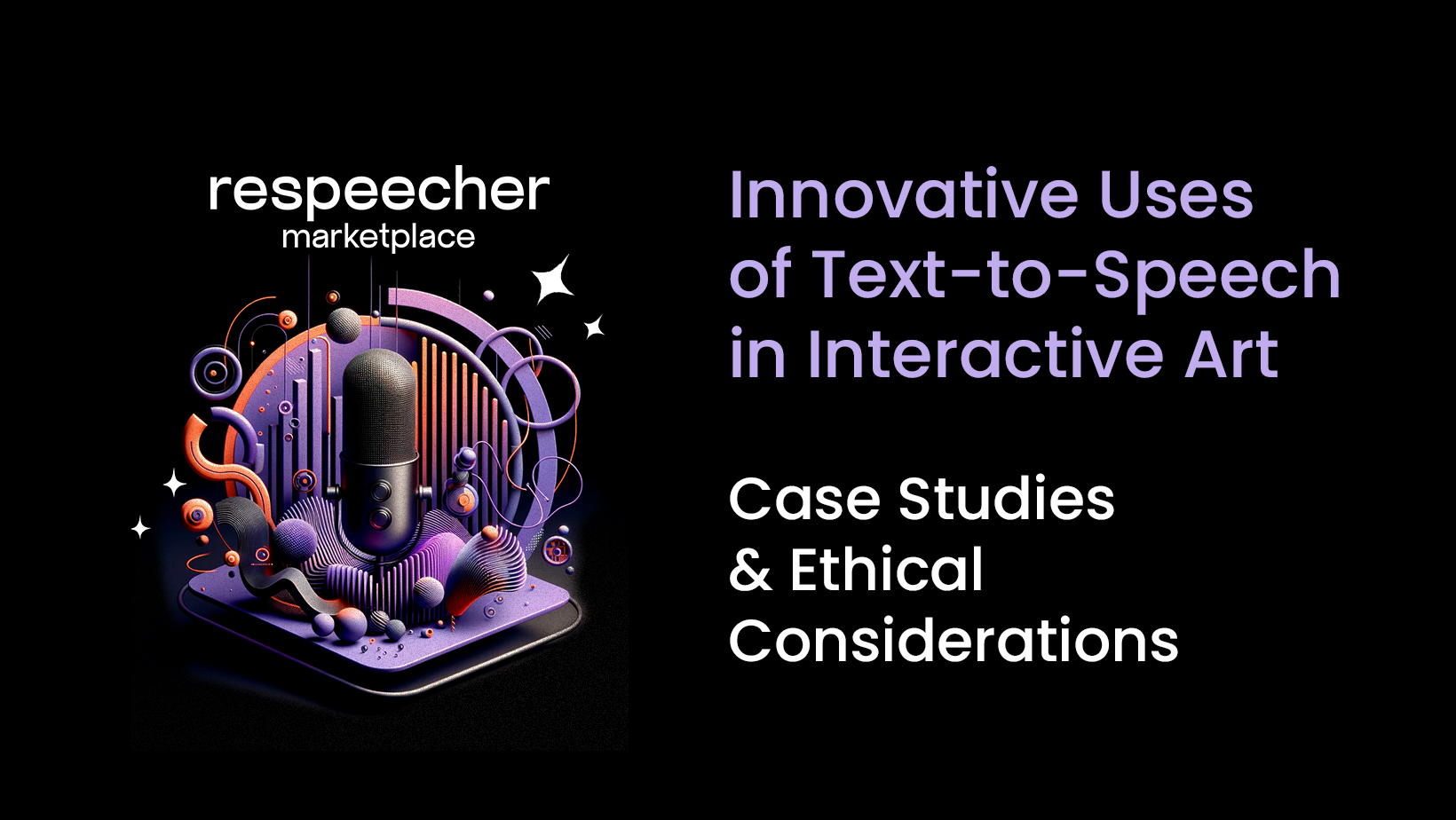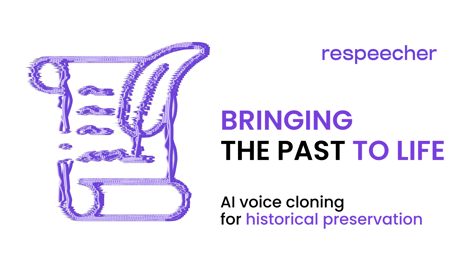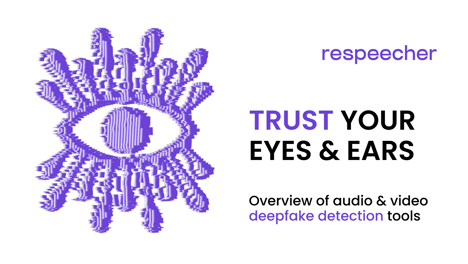Innovative Uses of Text-to-Speech in Interactive Art

In the past, the art was limited to static canvases or sculptures. Today, the contemporary art scene embraces technologies that blur the lines between creator and spectator, transforming passive observation into active participation. This shift towards interactivity has opened up new possibilities for artistic expression, where the boundaries between physical and digital realms are blurred, and the audience becomes an integral part of the artwork itself. Text-to-speech (TTS) technology serves as a catalyst for innovation in the creation of dynamic, AI voice-driven interactive artworks. Let’s see how TTS introduces a dynamic dimension to interactive art, blurring the boundaries between the physical and virtual worlds and inviting audiences to actively participate in the artistic experience.
Interactive Art and Text to Speech (TTS)
Text-to-speech technology has become a transformative tool for artists, empowering them to infuse their creations with dynamic auditory elements that transcend traditional boundaries of art. Through TTS, artists can seamlessly integrate spoken words into their artworks, adding a layer of interactivity and immersion that engages audiences on a deeper level, such as creating engaging content for museums.
One key benefit of TTS in interactive art is its ability to expand the scope of sensory experiences in art installations. By incorporating text to speech into their creations, artists can create immersive environments where sound plays a central role in shaping the narrative and atmosphere. Whether the gentle whisper of a character's voice or the booming echoes of a distant landscape, TTS synthesis enables artists to craft dynamic auditory experiences that captivate and enthrall audiences.
Moreover, text to speech technology allows for voice-driven narratives and responsive installations, where the audience's interactions dictate the progression of the artwork. Through voice commands or dialogues with AI-driven characters, viewers can actively shape the outcome of the artistic experience, blurring the lines between creator and spectator. This interactive element adds a new dimension to storytelling in art, fostering deeper engagement and emotional connection.
In addition to enhancing interactivity, text-to-speech plays a crucial role in diversifying the representation of characters and narratives within interactive art. By providing a voice to characters of various backgrounds, genders, and identities, TTS enables artists to create more inclusive and representative artworks. This diversity enriches the artistic experience and fosters audience empathy and understanding, promoting inclusivity and social change.
Furthermore, AI voice enabled art provides personalized encounters and accessibility, broadening its reach to audiences of all abilities and backgrounds. Through customizable settings and adaptive technologies, TTS ensures that everyone, regardless of language barriers or disabilities, can fully engage with and appreciate the artwork. This democratization of access makes digital art more inclusive and fosters a sense of belonging and connection within diverse communities.
Finally, text to speech voice synthesis contributes to the multisensory engagement of diverse audiences, enriching the artistic experience by integrating voice, sound, and visual elements. By appealing to multiple senses simultaneously, gen AI enabled artworks create immersive environments that resonate with viewers on a visceral level, leaving a lasting impression that transcends traditional modes of expression.
Case Studies: Art Projects and Immersive Text-to-Speech Storytelling
"The Listening Post" by Ben Rubin and Mark Hansen: This pioneering interactive art installation utilizes TTS technology to transform real-time internet conversations into spoken word compositions. The artwork consists of a large display of LED panels displaying fragments of online conversations, which are then synthesized into spoken words by text-to-speech technology. Audiences are invited to engage with the artwork by listening to the AI voices and exploring the evolving narrative created by the amalgamation of online discourse. "The Listening Post" has received widespread acclaim from audiences and the art community for its innovative use of text to speech synthesis to explore the intersection of technology, communication, and human connection.
"Whispers" by Rafael Lozano-Hemmer: In this interactive installation, TTS technology creates a participatory audio experience where visitors' whispers are recorded and transformed into spoken words that echo throughout the space. As visitors whisper into microphones placed around the exhibit, their voices are synthesized and played back continuously, creating an evolving cacophony of voices. "Whispers" has garnered praise for its ability to create an intimate and immersive environment that encourages self-expression and collective participation, highlighting the power of text-to-speech software to facilitate meaningful interactions between individuals and their surroundings.
Response from Audiences and the Art Community
The response to these interactive art projects utilizing TTS for immersive storytelling has been overwhelmingly positive from both audiences and the art community. Audiences have praised the innovative use of technology to create engaging and interactive experiences that blur the boundaries between art and everyday life. Many have expressed appreciation for these artworks' self-expression, participation, and reflection opportunities, highlighting the transformative impact of AI voices on their understanding of art and technology.
The art community has lauded these projects for their creativity, ingenuity, and ability to push the boundaries of traditional artistic mediums. Critics have commended the artists' adept use of TTS technology to explore themes of communication, identity, and social interaction, noting the profound emotional resonance of these immersive storytelling experiences. Moreover, these projects have sparked discussions within the art world about the role of technology in contemporary art and the potential of text-to-speech software to democratize content creators’ access to artistic expression.
Ethical Considerations in TTS for Art
As text-to-speech converters become more common, it's imperative to acknowledge and address the ethical considerations inherent in their use. Artists and technologists are responsible for ensuring that text-to-audio converters are employed ethically, with due respect for voice talent, cultural heritage, and the potential implications of creating and manipulating voices.
First and foremost, artists and technologists should recognize the importance of respecting voice talent and cultural heritage when utilizing AI voice generators in their creations. This involves obtaining appropriate permissions and licenses for using voices, whether sourced from individuals or cultural repositories. Furthermore, it's essential to approach the representation of voices and cultures with sensitivity and authenticity, avoiding stereotypes or misappropriation that could perpetuate harm or disrespect.
Consent is paramount in the ethical use of text-to-speech technology for artistic purposes. Artists must obtain informed consent from voice talent before using their voices in AI generated art, respecting their right to control how they are utilized and represented. Additionally, artists should be transparent with audiences about using TTS technology, providing clear attribution and acknowledgment of the voices involved. This transparency fosters trust and integrity within the artistic community, mitigating concerns of exploitation or misrepresentation.
It's also crucial to encourage dialogue and collaboration between artists, technologists, and ethicists to establish industry standards for ethical practices in the intersection of TTS technology and artistic creation. By engaging in open discourse and sharing best practices, stakeholders can develop guidelines and protocols that promote responsible use of voice AI while upholding ethical principles and values.
Conclusion
The intersection of text-to-speech technology and interactive art presents a realm of boundless creativity and innovation. As artists and curators continue to push the boundaries of artistic expression, embracing AI ethics considerations and responsible practices in utilizing TTS is essential. For those seeking to explore the transformative potential of text to speech software in interactive art, Respeecher's Voice Marketplace offers a unique opportunity to discover and leverage cutting-edge technology. With Respeecher, artists can access a diverse range of high-quality voices, enabling them to craft immersive narratives and dynamic experiences that captivate audiences and push the boundaries of artistic expression. Try it for free today.
FAQ
Text-to-speech (TTS) enables AI voice integration in interactive art, transforming written text into spoken word. It adds dynamic auditory elements, creating immersive storytelling and voice-driven narratives that engage audiences deeply. TTS in art allows for evolving narratives that react to audience interaction.
TTS creates immersive storytelling in art, enabling voice-driven narratives that respond to audience interactions. Viewers influence the artwork’s outcome through voice commands or AI dialogue, blurring the boundary between creator and spectator, making art interactive and participatory.
"The Listening Post" by Ben Rubin and Mark Hansen and "Whispers" by Rafael Lozano-Hemmer are notable examples of TTS in interactive art. Both projects utilize AI voice technology to transform audience input into evolving narratives, fostering engagement and deep immersion.
TTS technology democratizes access to digital art by enabling voice-driven narratives that enhance engagement for all abilities. It overcomes language barriers and aids accessibility, allowing a wider audience to experience and participate in interactive art.
When using TTS in art, it’s essential to obtain consent from voice talent, respect cultural heritage, and avoid misrepresentation. Transparency and ethical guidelines ensure responsible AI practices, avoiding exploitation and fostering trust and respect in AI voice technology.
Glossary
Text-to-speech (TTS)
Interactive art
Voice-driven narratives
Immersive storytelling
TTS for accessibility

- voice synthesis
- text-to-speech (TTS) synthesis
- Music
- AI voice generator
- generative AI
- Respeecher Voice Marketplace
- text to speech
- voice changer
- voice ai
- TTS
- text to speech converter
- text to audio converter
- interactive art
- text to speech in art
- AI artist
- digital art
- AI generated art
- AI in digital art





